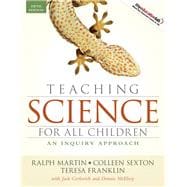
Note: Supplemental materials are not guaranteed with Rental or Used book purchases.
Purchase Benefits
Looking to rent a book? Rent Teaching Science for All Children An Inquiry Approach [ISBN: 9780205594917] for the semester, quarter, and short term or search our site for other textbooks by Martin, Ralph; Sexton, Colleen; Franklin, Teresa; Gerlovich, Jack; McElroy, Dennis. Renting a textbook can save you up to 90% from the cost of buying.
| Preface | |
| 4-E Methods for Teaching Science | |
| What is the Nature of Science? | |
| How Do Children Perceive Science? | |
| What Changes Have Occurred in Elementary Science? | |
| The Nature of Science | |
| Three Essential Features of Science | |
| The Aims of Standards and Research-Based Education | |
| How do Children Learn Science? | |
| What Role Does Brain Development and Processing Play in Learning? | |
| Where Do Children's Ideas Come From and How Do They Influence Learning? | |
| What Is the Dominant Perspective About How Children Learn Science? | |
| What Techniques and Roles Support Constructivist Learning? | |
| How Can You Improve Science Learning for Diverse Learners? | |
| Science For AllScience for Exceptional Children | |
| How Can Parents Help Meet Children's Special Needs? | |
| How Do You Plan for the Inquiry-Based Classroom? | |
| Using the National Science Education Standards and Promoting Inquiry | |
| Concept Mapping | |
| Planning Constructive Inquiry Science Lessons | |
| What Inquiry Methods Help Learners to Construct Understanding? | |
| What is Scientific Literacy? | |
| Science as Inquiry for Literacy | |
| Methods that Use Inquiry to Promote Student Concept Formation | |
| Techniques for Promoting Student Cooperation | |
| Recommendations for Enhancing Student's Learning of Science | |
| How Can You Use Questions to Foster Scientific Inquiry? | |
| Questions on Questions | |
| What Are the Different Types of Questions? | |
| What Are the Keys to Effective Questioning? | |
| How Can You Improve Your Questioning? | |
| Why Use Students' Questions | |
| How Do You Develop and Use Authentic Assessment? | |
| Evaluating Student Learning | |
| Selecting the Tool for the Task | |
| How Does Technology Enrich Scientific Inquiry? | |
| Why Use Educational Technology? | |
| How Can Educational Technology Be Applied in the Context of Science Teaching? | |
| What Is Integration? | |
| How Do You Plan for and Integrate Science with Other Disciplines? | |
| Approaches to Integration | |
| Challenges to Integration | |
| How Can You Design and Manage a Safe Inquiry-Based Science Classroom? | |
| Recommendations for Safe Science Experiences | |
| How Do You Plan for Safety? | |
| What Are Your Legal Responsibilities? | |
| Safety Equipment | |
| Performing Safety Assessments | |
| What Materials are Necessary for the Activities? | |
| Storage | |
| Room Arrangement | |
| A Final Thought | |
| What Materials and Resources Promote Inquiry-Based Science? | |
| Lessons Learned | |
| Selecting and Using Textbooks | |
| Best Practices | |
| Resources for Best Practices | |
| 4-E Inquiry Lessons for Teaching Science | |
| Life Science Lessons and Activities | |
| Physical Science Lessons and Activities | |
| Earth and Space Science Activities | |
| Appendix: National Science Education Standards: Contents Standards for Grades K-4 and 5-8 | |
| References | |
| Index | |
| Table of Contents provided by Publisher. All Rights Reserved. |
The New copy of this book will include any supplemental materials advertised. Please check the title of the book to determine if it should include any access cards, study guides, lab manuals, CDs, etc.
The Used, Rental and eBook copies of this book are not guaranteed to include any supplemental materials. Typically, only the book itself is included. This is true even if the title states it includes any access cards, study guides, lab manuals, CDs, etc.